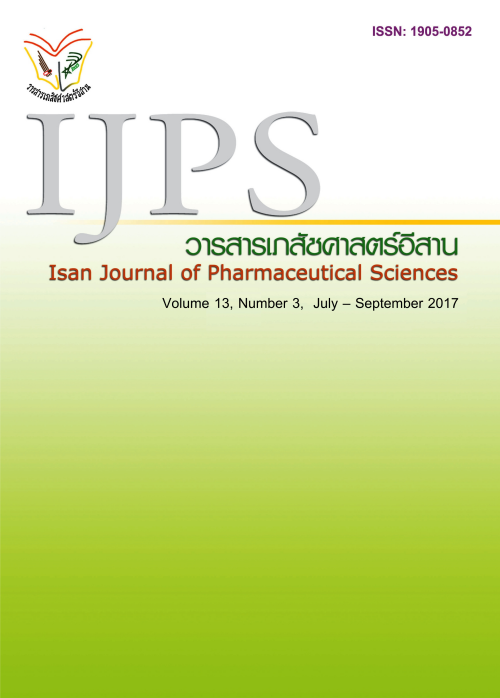Medication Preparedness for Emergency Flooding Situations of Public Hospitals in Central Thailand: A Case Study of Flooding Crisis in 2011
Main Article Content
Abstract
Introductions: Hospitals situated in central Thailand are at high risk of emergency flooding situations. Medication preparedness for emergency flooding situations (EFS) is important for public hospitals, where most healthcare services are delivered to the Thai people. This research aimed to survey medication preparedness for EFS of public hospitals in central Thailand. Methods: Medication preparedness was surveyed using a questionnaire designed for this study based on the Medical and Public Health Preparedness Plan 2010. The questionnaires were sent to 76 public hospitals in 8 provinces in the central region affected by the floods in 2011. Overall medication preparedness was assessed on 7 components into 3 levels: high (score 6-7), moderate (3-5), and low (0-2). Results: Thirty-two hospitals returned the questionnaire (42.1%response rate). Five from seven tertiary care hospitals (71.4%) and 17 from 25 community hospitals (68.0%) reported of having moderate level of medication preparedness for EFS. Twenty-nine hospitals (90.6%) had performed risk assessment of flood, created a list and determined minimum stock of emergency medications for flood. Twenty-six hospitals (84.4%) had established a public health emergency response plan for flood and assigned specific roles to each responding unit. About half of the hospitals (46.9%) had tabletop exercises for emergency response plan. Eight from thirty-two hospitals (25.0%) reported of creating specific medication lists for EFS. A list of emergency medications for EFS was created by hospital Pharmaceutical and Therapeutic Committee, covering medications for common diseases, infectious diseases and chronic diseases. Emergency medications for EFS were stocked for a minimum of 2-3 months. Thirty hospitals (93.8%) had established a supply network for EFS. Eight from thirty-two hospitals (25.0%) had had an informal agreement with manufacturers or distributors on speed delivery of intravenous solutions. Twenty hospitals (62.5%) created a database of EFS organizations and contact persons. Eleven hospitals (34.4%) provided public health personnel trainings on emergency medications, medication delivery, and medication management for chronic diseases for personnel at district hospitals, sub-district hospitals, local administrative authorities, and health volunteers. Only 5 hospitals (26.3%) provided information on emergency medication for patients and public. Conclusion: Most hospitals had moderate level of medication preparedness for EFS. Functional exercise of emergency plan, establishment of emergency medication lists, and public education on emergency medication for EFS should be carried out.
Article Details
In the case that some parts are used by others The author must Confirm that obtaining permission to use some of the original authors. And must attach evidence That the permission has been included
References
Alderman K, Lyle RT, Shilu T. Floods and human health: a systematic review. Environment International 2012; 47: 37-47.
Baharuddin KA, Abdull Wahab SF, Nik Ab Rahman NH, et al. The record-setting flood of 2014 in Kelantan: challenges and recommendations from an emergency medicine perspective and why the medical Campus Stood Dry. Malays J Med Sci 2015; 22(2): 1-7.
Bureau of Policy and Strategy, Ministry of Public Health. Medications and Public Health Preparedness Plan 2010 [Online]. 2010. [Cited 2013 December 1]; Available from:http://bps.ops.moph.go.th/.
Center for Research on the Epidemiology of Disasters. The International Disaster Database [Online]. 2013 [cited 2014 Mar 22]; Available from: http://www.emdat.be.
Department of Disaster Prevention and Mitigation Ministry of Interior Thailand. National Disaster Prevention and Mitigation Plan 2010-2014 [Online] 2010. [Cited 2013 December 1]; Available from: http://www.disaster.go.th/.
Department of Disease Control Ministry of Public Health Thailand. Guideline of Inventory Management for Public Health Emergency. Nonthaburi: Thailand Agriculture Cooperatives Group; 1997.
Department of Disease Control Ministry of Public Health Thailand. 5 Millions Chronic Disease Patients are in Risk of Medicines Lacking from Flooding. Thairuthonline. [Online] 2011 October 28. [cited 2013 December 1]; Available from: http://www.thairath.co.th/content/212433.
Department of Disease Control Ministry of Public Health Thailand. Guideline for Development of Emergency Operation Center and Incidence Command Systems of 2016-2021. Nonthaburi: Thailand Agriculture Cooperatives Group; 2015.
Minh HV, Anh TT, Rocklöv J, et al. Primary healthcare system capacities for responding to storm and flood-related health problems: a case study from a rural district in central Vietnam. Global Health Action 2014; 7: 1-14.
National Institute of Emergency Medicine Ministry of Public Health Thailand. Guidelines for Exercise of Public Disaster Plan at Regional Level 2016. [Online] 2016. [Cited 2016 December 14]; Available from: http://110.164.192.180/pher/view_topic_popup.php?idview=403.
National Statistical Office, Ministry of Digital Economy and Society Thailand. Summary of Effects to Industrial Productions from A Survey Project of Business and Industry in 2012. [Online]. 2013. [cited 2013 December 11]; Available from: http://service.nso.go.th/nso/nsopublish/census/files/industry_flood.pdf.
National Statistical Office, Ministry of Digital Economy and Society Thailand. Executive Summary: A Survey of Affected Houses from Flooding in 2011 July -December. [Online]. 2013 [cited 2013 December 1]; Available from: http://service.nso.go.th/nso/ nsopublish/themes/theme_2-4-12.html.
Office of the Permanent Secretary Ministry of Public Health Thailand. Preparedness Operation for Flooding. [Online]. 2014 Sep 3. [Cited 2015 December 1]; Available from: http://110.164.192.180/pher/ view_topic_popup.php?idview=132.
Opasanon S. Viewpoint of Logistic Management on Flooding Crisis. Journal of Business Management. Faculty of Commerce and Accountancy Thammasat University. October – December 2011; 34(132) :6-9. [Internet] 2013. [cited 2013 December 1]; Available from: http://www.jba.tbs.tu.ac.th/files/Jba132/Colum/JBA132SathapornC.pdf.
Phalkey R, Dash SR, Mukhopadhyay A, Runge-Ranzinger S, Marx M. Prepared to react? Assessing the functional capacity of the primary health care system in rural Orissa, India to respond to the devastating flood of September 2008. Global Health Action 2012; 5: 1-10.
Suriyawongpaisal P. The Great Flood in 2011: Lesson Learned from Experiences. [Report] 2012 Sep. Nonthaburi: Health Systems Research Institute; 2012.
Waleekhachonloet A. et al. Medications Preparedness for Disaster Situation.[Report][Internet] 2013. [cited 2017 July 4] Available from: http://kb.hsri.or.th/dspace/handle/11228/3878?locale-attribute=th
Working group for synthesis of lesson learned of management of great flood 2011. Synthesis of Lesson Learned from Management of Great Flood 2011. [Report] 2012 Sep. Nonthaburi: Health Systems Researches Institute; 2012.
World Health Organization. Selection of medicine and medical devices included in the Interagency Emergency Health Kit 2011: Medicines and Medical devices for 10 000 people for approximately three months 2011.[Internet] France;2011 [cited 2015 December 11]. 72 p. Available from: http://www.who.int/medicines/publications/emergencyhealthkit2011/en/.


